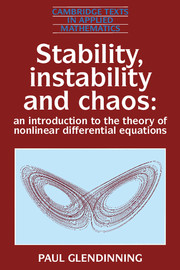Book contents
- Frontmatter
- Contents
- Preface
- Notation
- 1 INTRODUCTION
- 2 STABILITY
- 3 LINEAR DIFFERENTIAL EQUATIONS
- 4 LINEARIZATION AND HYPERBOLICITY
- 5 TWO DIMENSIONAL DYNAMICS
- 6 PERIODIC ORBITS
- 7 PERTURBATION THEORY
- 8 BIFURCATION THEORY I: STATIONARY POINTS
- 9 BIFURCATION THEORY II: PERIODIC ORBITS AND MAPS
- 10 BIFURCATIONAL MISCELLANY
- 11 CHAOS
- 12 GLOBAL BIFURCATION THEORY
- Notes and further reading
- Bibliography
- Index
12 - GLOBAL BIFURCATION THEORY
Published online by Cambridge University Press: 05 June 2012
- Frontmatter
- Contents
- Preface
- Notation
- 1 INTRODUCTION
- 2 STABILITY
- 3 LINEAR DIFFERENTIAL EQUATIONS
- 4 LINEARIZATION AND HYPERBOLICITY
- 5 TWO DIMENSIONAL DYNAMICS
- 6 PERIODIC ORBITS
- 7 PERTURBATION THEORY
- 8 BIFURCATION THEORY I: STATIONARY POINTS
- 9 BIFURCATION THEORY II: PERIODIC ORBITS AND MAPS
- 10 BIFURCATIONAL MISCELLANY
- 11 CHAOS
- 12 GLOBAL BIFURCATION THEORY
- Notes and further reading
- Bibliography
- Index
Summary
The treatment of bifurcations in previous chapters has been based on a local analysis of the flow near a stationary point or a periodic orbit. There is another class of bifurcations which is just as fundamental as these local bifurcations but which depends on global properties of the flow. A simple example of such a bifurcation is shown in Figure 12.1. We consider a planar flow depending upon a parameter µ such that for µ > 0 there is a stable periodic orbit enclosing an unstable focus and a saddle outside the periodic orbit with stable and unstable manifolds as sketched in Figure 12.1a. As µ decreases to zero the periodic orbit approaches the saddle and when µ = 0 the periodic orbit collides with the saddle to form an orbit called a homoclinic orbit. So at µ = 0 one branch of the stable manifold of the saddle coincides with a branch of the unstable manifold of the saddle. By Peixoto's Theorem (Theorem 4.13) this is structurally unstable, and so typical small perturbations of the system will not have a homoclinic orbit, and in µ < 0 (Fig. 12.1c) this connection has been broken and we see that the periodic orbit has disappeared. Hence the homoclinic bifurcation at µ = 0 has destroyed the periodic orbit. We shall see that more complicated homoclinic bifurcations can create chaotic behaviour, but to begin with we shall stick to the two-dimensional situation, starting with an example.
- Type
- Chapter
- Information
- Stability, Instability and ChaosAn Introduction to the Theory of Nonlinear Differential Equations, pp. 338 - 376Publisher: Cambridge University PressPrint publication year: 1994



